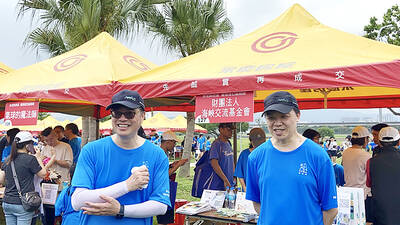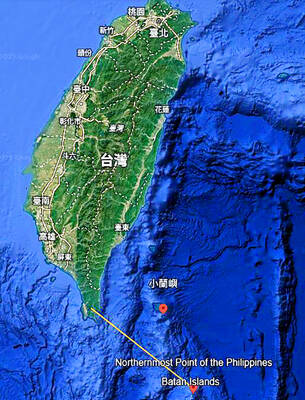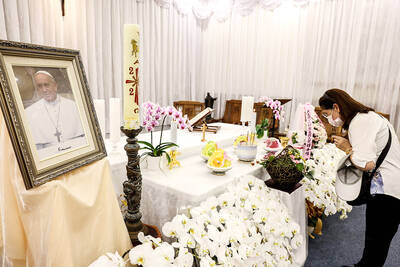A US aircraft carrier yesterday docked in Hong Kong, days after a pair of strategic bombers flew over the disputed South China Sea.
The arrival of the USS Ronald Reagan and its battle group in the Asian financial hub came after China rejected a similar request by another US Navy ship amid a spike in tensions between the countries’ militaries.
The Reagan’s visit is being seen as a friendly gesture ahead of a planned meeting later this month between US President Donald Trump and Chinese President Xi Jinping (習近平) that would mark the first time they have sat down together since the start of a bitter trade dispute.

Photo: Bloomberg
China has demanded that the US cease military activity of any kind near its island claims in the South China Sea that it has been rapidly fortifying.
The US has said it takes no stance on sovereignty claims, but would continue to sail and operate wherever international law permits.
The US Navy said in a statement that during the Reagan’s visit, interactions would take place with Hong Kongers through sports, community relations projects and tours of the carrier. More than 4,400 men and women are usually aboard the ship.
“The abundant growth and prosperity that surrounds us in Hong Kong is what the United States Seventh Fleet seeks to preserve for all nations in this important region,” Rear Admiral Karl Thomas, commander of Carrier Strike Group 5, said in the statement.
In comments to Hong Kong media on Tuesday, Thomas said the US and Chinese militaries are able to maintain a professional relationship, despite tensions.
“When we’re out at sea, we have a mission to do, and we come out and operate around each other, and we do it professionally,” Thomas said.
Meanwhile, US Pacific Air Forces said two B-52s flew over the South China Sea on Monday, calling it a “routine training mission.”
The bombers departed Andersen Air Force Base on Guam as part of the US Indo-Pacific Command’s continuous bomber presence operations that began in 2004, Pacific Air Forces said in a statement yesterday.
“This recent mission is consistent with international law and the United States’ long-standing commitment to a free and open Indo-Pacific,” the statement said.
Also this week, China has installed a new platform in the South China Sea on a remote part of the Paracel Islands (Xisha Islands, 西沙群島) that could be used for military purposes, according to recent satellite images reviewed by a US think tank.
The Asia Maritime Transparency Initiative of the Washington-based Center for Strategic and International Studies said that the images showed a “modest new structure” on Bombay Reef (浪花礁), topped by a radome and solar panels.
“The development is interesting given Bombay Reef’s strategic location, and the possibility that the structure’s rapid deployment could be repeated in other parts of the South China Sea,” the group said in a statement on Tuesday.
The purpose of the structures was unclear, but it could be for military use, it said.
“The reef is directly adjacent to the major shipping lanes that run between the Paracels and the Spratly Islands [Nansha Islands, 南沙群島] to the south, making it an attractive location for a sensor array to extend Chinese radar or signals intelligence collection over that important sea lane,” the group said.
The Chinese Ministry of National Defense did not respond to a request for comment.
Chinese Ministry of Foreign Affairs spokesman Geng Shuang (耿爽) said China’s sovereignty over the Paracel Islands was not in dispute, and there is nothing wrong with China carrying out construction work on its own territory.
“As for the specific situation you mention, I have no understanding of it,” Geng told a daily news briefing.
Taiwan and Vietnam also claim the Paracels.
The Vietnamese Ministry of Foreign Affairs did not immediately respond to a request for comment.
Additional reporting by Reuters

SECURITY: As China is ‘reshaping’ Hong Kong’s population, Taiwan must raise the eligibility threshold for applications from Hong Kongers, Chiu Chui-cheng said When Hong Kong and Macau citizens apply for residency in Taiwan, it would be under a new category that includes a “national security observation period,” Mainland Affairs Council (MAC) Minister Chiu Chui-cheng (邱垂正) said yesterday. President William Lai (賴清德) on March 13 announced 17 strategies to counter China’s aggression toward Taiwan, including incorporating national security considerations into the review process for residency applications from Hong Kong and Macau citizens. The situation in Hong Kong is constantly changing, Chiu said to media yesterday on the sidelines of the Taipei Technology Run hosted by the Taipei Neihu Technology Park Development Association. With

CARROT AND STICK: While unrelenting in its military threats, China attracted nearly 40,000 Taiwanese to over 400 business events last year Nearly 40,000 Taiwanese last year joined industry events in China, such as conferences and trade fairs, supported by the Chinese government, a study showed yesterday, as Beijing ramps up a charm offensive toward Taipei alongside military pressure. China has long taken a carrot-and-stick approach to Taiwan, threatening it with the prospect of military action while reaching out to those it believes are amenable to Beijing’s point of view. Taiwanese security officials are wary of what they see as Beijing’s influence campaigns to sway public opinion after Taipei and Beijing gradually resumed travel links halted by the COVID-19 pandemic, but the scale of

A US Marine Corps regiment equipped with Naval Strike Missiles (NSM) is set to participate in the upcoming Balikatan 25 exercise in the Luzon Strait, marking the system’s first-ever deployment in the Philippines. US and Philippine officials have separately confirmed that the Navy Marine Expeditionary Ship Interdiction System (NMESIS) — the mobile launch platform for the Naval Strike Missile — would take part in the joint exercise. The missiles are being deployed to “a strategic first island chain chokepoint” in the waters between Taiwan proper and the Philippines, US-based Naval News reported. “The Luzon Strait and Bashi Channel represent a critical access

Pope Francis is be laid to rest on Saturday after lying in state for three days in St Peter’s Basilica, where the faithful are expected to flock to pay their respects to history’s first Latin American pontiff. The cardinals met yesterday in the Vatican’s synod hall to chart the next steps before a conclave begins to choose Francis’ successor, as condolences poured in from around the world. According to current norms, the conclave must begin between May 5 and 10. The cardinals set the funeral for Saturday at 10am in St Peter’s Square, to be celebrated by the dean of the College